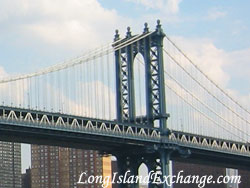The Manhattan Bridge
The Manhattan Bridge was first planned as a traditional wire-cable suspension bridge to be used exclusively by trains. The work on the Manhattan Bridge began in the last quarter of 1901. When it was first opened, the tracks didn't connect to any others. The elevated railway magnate Frederick Uhlmann proposed this span just north of the present site of the Manhattan Bridge in 1892. It was planned in conjunction with another one of his proposals, the Williamsburg Bridge. While Uhlmann's railroad bridge was never constructed, the Williamsburg Bridge was approved in 1895 to handle mixed traffic. After the engineers inspecting the Manhattan Bridge found cracking and corrosion in 1978, they concluded that the cracking originated from one-sided trainloads on the outboard structures. In 1982, the New York City Department of Transportation (NYCDOT) decided to rebuild the existing Manhattan Bridge and the work was to be carried out under three separate contracts, the first two for stiffening the side and main spans, followed by a third one for the installation of prefabricated panels on the lower roadway. The reconstruction project cost an approximation of $646 million and the bridge will carry about 150,000 vehicles per day (AADT). The suspension cables and light blue towers make the bridge appear almost delicate in comparison to its neighbors. Pedestrians enjoy unusual views as they stroll across its expanse. Commuters in a hurry may rarely notice, but the entrance on the Canal Street side has an ornamental arch and large colonnades that lend an artistic and a grand touch to those who use the bridge with time to admire the surroundings. Integrated with a superb set of approaches designed by the renowned architectural team of Carrere and Hastings, the Manhattan Bridge is amongst the most esthetically pleasing of New York City's transportation structures. |
|
||||||||||||||||||||||||
| ||||||||||||||||||||||||
|

 The Manhattan Bridge is a suspension bridge that crosses the East River and connecting Lower
The Manhattan Bridge is a suspension bridge that crosses the East River and connecting Lower 